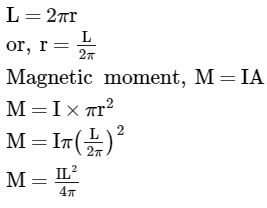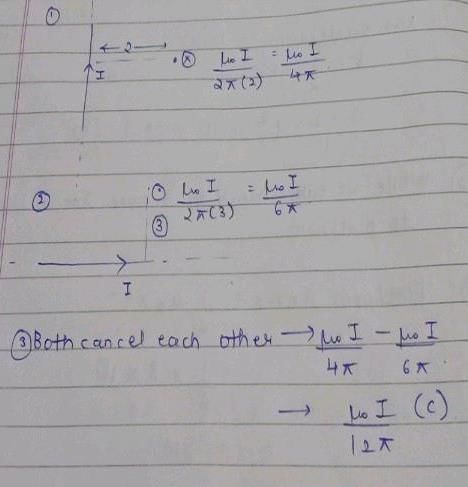All Exams >
JAMB >
Physics for JAMB >
All Questions
All questions of Magnetism for JAMB Exam
A current carrying wire is placed in the grooves of an insulating semi circular disc of radius `R', as shown. The current enters at point A and leaves from point B. Determine the magnetic field at point D. 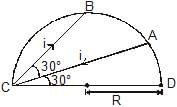
- a)

- b)

- c)

- d)None of these
Correct answer is option 'B'. Can you explain this answer?
A current carrying wire is placed in the grooves of an insulating semi circular disc of radius `R', as shown. The current enters at point A and leaves from point B. Determine the magnetic field at point D.
a)
b)
c)
d)
None of these
|
|
Mira Joshi answered |

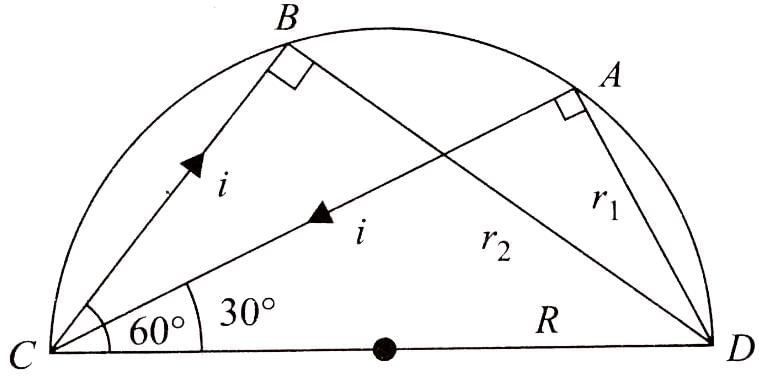

If we double the radius of a current carrying coil keeping the current unchanged. what happens to the magnetic field at its Centre?- a)halved
- b)doubled
- c)remains unchanged
- d)becomes four times
Correct answer is option 'A'. Can you explain this answer?
If we double the radius of a current carrying coil keeping the current unchanged. what happens to the magnetic field at its Centre?
a)
halved
b)
doubled
c)
remains unchanged
d)
becomes four times

|
Ciel Knowledge answered |
As,
B=μonI/2a
a ->radius
B ∝1/a
B1/B2=a2/a1
B1=2B2
B2=(1/2) x B1,
Magnetic field is halved.
B=μonI/2a
a ->radius
B ∝1/a
B1/B2=a2/a1
B1=2B2
B2=(1/2) x B1,
Magnetic field is halved.
Two thin long parallel wires separated by a distance b are carrying a current i ampere each. The magnitude of the force per unit length exerted by one wire on the other is- a)

- b)

- c)

- d)

Correct answer is option 'D'. Can you explain this answer?
Two thin long parallel wires separated by a distance b are carrying a current i ampere each. The magnitude of the force per unit length exerted by one wire on the other is
a)
b)
c)
d)

|
EduRev Humanities answered |
Given, i1=i2=i
∴F=μ0i2l/2πb
Hence, force per unit length is F=μ0i2/2πb
∴F=μ0i2l/2πb
Hence, force per unit length is F=μ0i2/2πb
An electron with a speed of 1.8 x 106 m/s is moving in a circular orbit in a uniform magnetic field of 10-4 Wb/m², the radius of the circular path of the electron is
- a)10.63 m
- b)1.063 m
- c)106.3 m
- d)0.1063 m
Correct answer is option 'D'. Can you explain this answer?
An electron with a speed of 1.8 x 106 m/s is moving in a circular orbit in a uniform magnetic field of 10-4 Wb/m², the radius of the circular path of the electron is
a)
10.63 m
b)
1.063 m
c)
106.3 m
d)
0.1063 m

|
Learners Habitat answered |
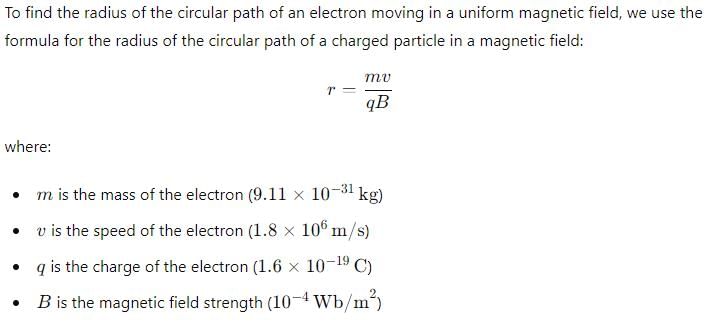
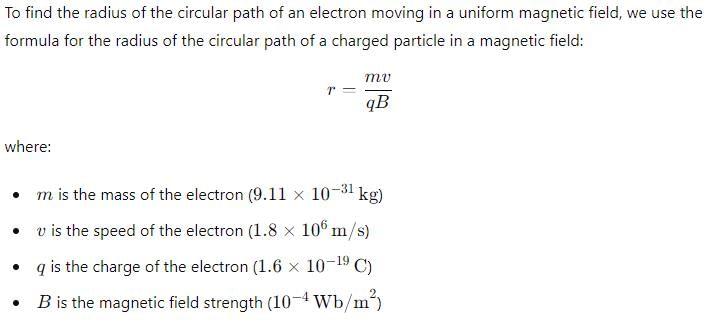
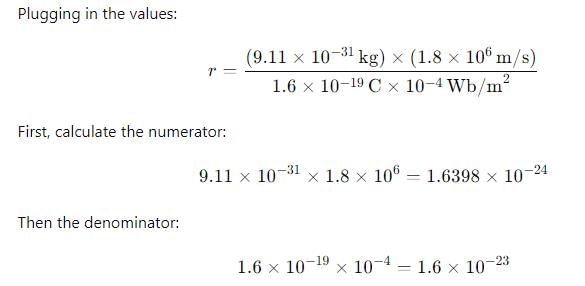
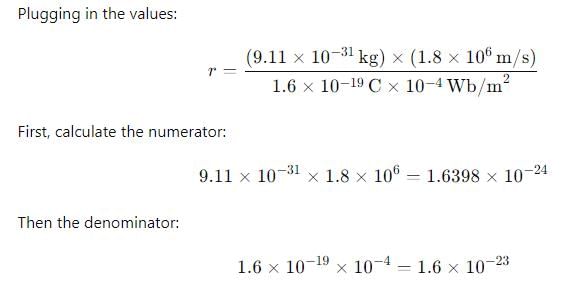
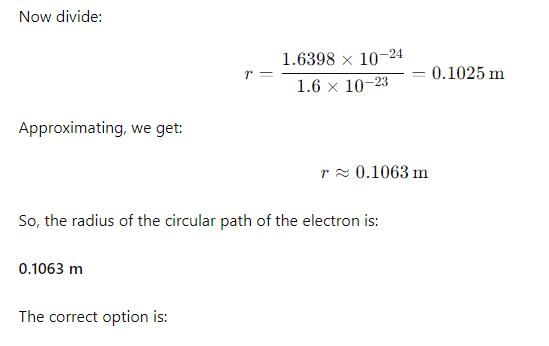
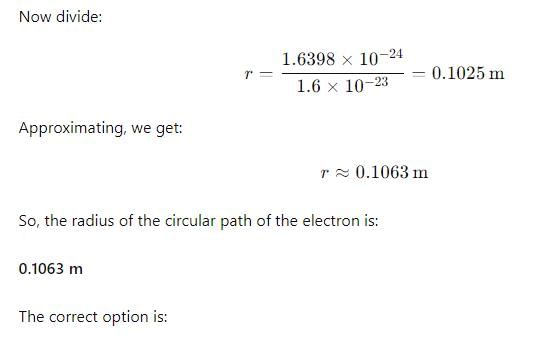
4. 0.1063 m
An electron and proton enter a magnetic field with equal velocities. Which one of them experiences a greater force?- a)electron
- b)proton
- c)Both experience same magnitude of force
- d)No prediction can be made.
Correct answer is option 'C'. Can you explain this answer?
An electron and proton enter a magnetic field with equal velocities. Which one of them experiences a greater force?
a)
electron
b)
proton
c)
Both experience same magnitude of force
d)
No prediction can be made.

|
Divey Sethi answered |
As charges and velocities are same
F=q(V×B)
So having the same magnitude of charge and same velocity, they'll experience the same magnitude of force.
F=q(V×B)
So having the same magnitude of charge and same velocity, they'll experience the same magnitude of force.
Two concentric coils carry the same current in opposite directions. The diameter of the inner coil is half that of the outer coil. If the magnetic field produced by the outer coil at the common centre are 1 T, the net field at the centre is
- a)4T
- b)2T
- c)1T
- d)3T
Correct answer is option 'C'. Can you explain this answer?
Two concentric coils carry the same current in opposite directions. The diameter of the inner coil is half that of the outer coil. If the magnetic field produced by the outer coil at the common centre are 1 T, the net field at the centre is
a)
4T
b)
2T
c)
1T
d)
3T
|
|
Krishna Iyer answered |
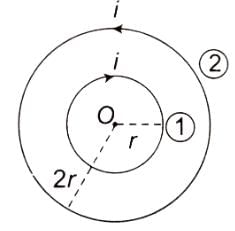
The magnetic field produced by a current-carrying coil at its center is given by the formula,
B = μ0 * (N*I/R),
where,
B is the magnetic field,
μ0 is the permeability of free space,
N is the number of turns in the coil,
I is the current through the coil, and
R is the radius of the coil.
In this case, both the coils carry the same current but in opposite directions. So, the fields produced by them will be in opposite directions. Also, the diameter of the inner coil is half that of the outer coil. Thus, the radius of the inner coil will be half that of the outer coil.
Therefore, the field at the center due to the inner coil will be double that due to the outer coil (because the magnetic field is inversely proportional to the radius).
Since the fields are in opposite directions, the net field at the center will be the difference between the two fields. That is, 2B (due to the inner coil) - B (due to the outer coil) = B.
So, if the field due to the outer coil is 1 T (Tesla), the net field at the center will also be 1 T.
Hence, the correct answer is 3. 1T.
Ampere’s circuital law is analogous to a law in electrostatics.That law is- a)Gauss’s law
- b)Kirchhoff’s law
- c)Faraday’s law
- d)Coulomb’s law
Correct answer is option 'A'. Can you explain this answer?
Ampere’s circuital law is analogous to a law in electrostatics.That law is
a)
Gauss’s law
b)
Kirchhoff’s law
c)
Faraday’s law
d)
Coulomb’s law
|
|
Vijay Bansal answered |
Ampere's law is similar to Guass's law in electrostatics.
Guass's law corelates surface integral of electric field E with charge q over a surface.
Ampere's law corelates the line integral of magnetic field B with current over a closed path.
The magnetic field due to circular coil of 200 turns of diameter 0.1m carrying a current of 5A at a point on the axis of the coil at a distance 0.15m from the center of the coil will be- a)

- b)

- c)

- d)

Correct answer is option 'D'. Can you explain this answer?
The magnetic field due to circular coil of 200 turns of diameter 0.1m carrying a current of 5A at a point on the axis of the coil at a distance 0.15m from the center of the coil will be
a)
b)
c)
d)
|
|
Krishna Iyer answered |
B=μ02πnIa2/4π (a2+x2)3/2
=10−7×2×(22/7)×200×5×(0⋅1/2)2/ [(0⋅1/2)2+(0⋅15)2]3/2
=39.74x10-5
=10−7×2×(22/7)×200×5×(0⋅1/2)2/ [(0⋅1/2)2+(0⋅15)2]3/2
=39.74x10-5
Which combination of magnetic field lines and poles shows two magnets repelling each other?- a)

- b)

- c)

- d)

Correct answer is option 'B'. Can you explain this answer?
Which combination of magnetic field lines and poles shows two magnets repelling each other?
a)
b)
c)
d)

|
Dr Manju Sen answered |
- The discovery that one particular pole of a magnet orients northward, whereas the other pole orients southward allowed people to identify the north and south poles of any magnet.
- It was then noticed that the north poles of two different magnets repel each other, and likewise for the south poles. Conversely, the north pole of one magnet attracts the south pole of other magnets.
- This situation is analogous to that of electric charge, where like charges repel and unlike charges attract. In magnets, we simply replace the charge with a pole: Like poles repel and unlike poles attract.
In the figure shown, what is ? The magnitude of current is the same in all three wires.
? The magnitude of current is the same in all three wires.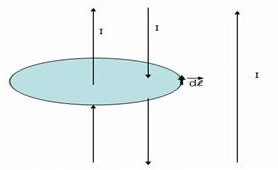
- a)2I
- b)–I
- c)I
- d)Zero
Correct answer is option 'D'. Can you explain this answer?
In the figure shown, what is ? The magnitude of current is the same in all three wires.
? The magnitude of current is the same in all three wires.
a)
2I
b)
–I
c)
I
d)
Zero

|
Yogesh Singla answered |
It is equal to the total current threading the loop which is equal to zero hence option D is correct
If a long hollow copper pipe carries a direct current, the magnetic field associated with the current will be- a)only outside the pipe
- b)only inside the pipe
- c)neither outside nor inside the pipe
- d)both inside and outside the pipe
Correct answer is option 'A'. Can you explain this answer?
If a long hollow copper pipe carries a direct current, the magnetic field associated with the current will be
a)
only outside the pipe
b)
only inside the pipe
c)
neither outside nor inside the pipe
d)
both inside and outside the pipe
|
|
Hansa Sharma answered |
For a loop inside the hollow portion of the conductor, the current enclosed is zero until the loop is on the surface or inside the material of the conductor.
∴Binside=0
For any loop outside, current enclosed by the amperian loop is not zero, hence the magnetic field is non-zero.
∴Binside=0
For any loop outside, current enclosed by the amperian loop is not zero, hence the magnetic field is non-zero.
A bar magnet of magnetic moment 1.5 J/T lies parallel to the direction of a uniform magnetic field of 0.22 T. What is the torque acting on it?- a)-0.3J
- b)0.23J
- c)0.0J
- d)0.3J
Correct answer is option 'B'. Can you explain this answer?
A bar magnet of magnetic moment 1.5 J/T lies parallel to the direction of a uniform magnetic field of 0.22 T. What is the torque acting on it?
a)
-0.3J
b)
0.23J
c)
0.0J
d)
0.3J
|
|
Preeti Iyer answered |
Answer :-
Solution :- torque when  =180°
=180°
 =180°
=180°
= 1.5 × 0.22 × sin 180°
= 0.33 × 0 = 0 Nm
A proton with 1MeV kinetic energy is moving in a circular path of radius R in a uniform magnetic field. What should be the energy of an α – particle to describe a circle of same radius in the same magnetic field?- a)2 MeV
- b)0.5 MeV
- c)1 MeV
- d)4 MeV
Correct answer is option 'C'. Can you explain this answer?
A proton with 1MeV kinetic energy is moving in a circular path of radius R in a uniform magnetic field. What should be the energy of an α – particle to describe a circle of same radius in the same magnetic field?
a)
2 MeV
b)
0.5 MeV
c)
1 MeV
d)
4 MeV

|
Shraddha Singh answered |
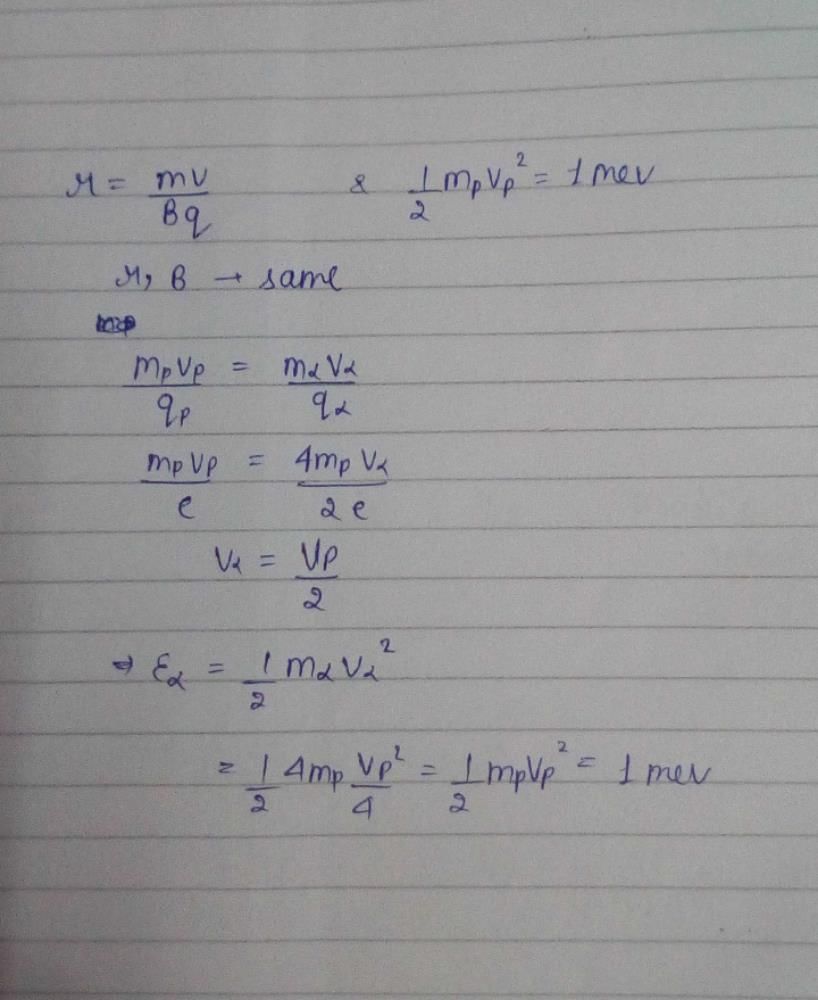
A toroid wound with 60.0 turns/m of wire carries a current of 5.00 A. The torus is iron, which has a magnetic permeability of μm=5000μ0 under the given conditions. H and B inside the iron are- a)340AT/m,2.88T
- b)340AT/m,1.88T
- c)380AT/m,1.98T
- d)300AT/m,1.88T
Correct answer is option 'D'. Can you explain this answer?
A toroid wound with 60.0 turns/m of wire carries a current of 5.00 A. The torus is iron, which has a magnetic permeability of μm=5000μ0 under the given conditions. H and B inside the iron are
a)
340AT/m,2.88T
b)
340AT/m,1.88T
c)
380AT/m,1.98T
d)
300AT/m,1.88T
|
|
Neha Sharma answered |
B=B0+Bm
= μ0nI+ μmnI
=nI(μ+ μm)
=60x5(5000μ0+ μ0)
B=300(5001μ0)
B=1.88T
H=B/μm
=300x5001μ0/5000μ
=300AT
= μ0nI+ μmnI
=nI(μ+ μm)
=60x5(5000μ0+ μ0)
B=300(5001μ0)
B=1.88T
H=B/μm
=300x5001μ0/5000μ
=300AT
Wire of length l, carries a steady current I. It is bent first to form a circular coil of one turn. The same wire of same length is now bent more sharply to give two loops of smaller radius the magnetic field at the centre caused by the same current is- a)one third of its initial value
- b)nine times of its initial value
- c)four times of its initial value
- d)unaltered
Correct answer is option 'C'. Can you explain this answer?
Wire of length l, carries a steady current I. It is bent first to form a circular coil of one turn. The same wire of same length is now bent more sharply to give two loops of smaller radius the magnetic field at the centre caused by the same current is
a)
one third of its initial value
b)
nine times of its initial value
c)
four times of its initial value
d)
unaltered
|
|
Om Desai answered |
Let the radii be r1 and r2 respectively.
Since there are two turns of radius r2, r1=2r2
Magnetic field B at the centre of the coil of radius r1 B1=μoi/2r1=μoi/4r2
Magnetic field B at the center of the coil of radius r2 B2=2×μoi/2r2
∴ B2/B1 =(2× μoi/2r2)/(μoi /4r2) =4
Hence the answer is option C, four times its initial value.
Since there are two turns of radius r2, r1=2r2
Magnetic field B at the centre of the coil of radius r1 B1=μoi/2r1=μoi/4r2
Magnetic field B at the center of the coil of radius r2 B2=2×μoi/2r2
∴ B2/B1 =(2× μoi/2r2)/(μoi /4r2) =4
Hence the answer is option C, four times its initial value.
When the switch is closed a magnetic field is produced by the coil. Which answer shows the shape of the field?- a)

- b)
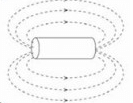
- c)
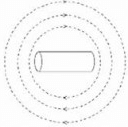
- d)

Correct answer is option 'B'. Can you explain this answer?
When the switch is closed a magnetic field is produced by the coil. Which answer shows the shape of the field?
a)
b)
c)
d)

|
Anand Kumar answered |
Ya it's B ....
Emerges from one side and enter from another side...
Emerges from one side and enter from another side...
Ratio of magnetic force Fm and electric force Fe acting on a charge getting undeflected through the field is- a)E/B
- b)B/E
- c)1
- d)0
Correct answer is option 'C'. Can you explain this answer?
Ratio of magnetic force Fm and electric force Fe acting on a charge getting undeflected through the field is
a)
E/B
b)
B/E
c)
1
d)
0
|
|
Lavanya Menon answered |
if the particle is undeflected, then the magnetic force equals the electric force:
q x v x B=q x E
B is the magnitude of the magnetic field
E is the magnitude of the electric field
v is the magnitude of the velocity of the particle.
If the forces are equal then:
v=E/B
For undeflected v=1
E/B=1
q x v x B=q x E
B is the magnitude of the magnetic field
E is the magnitude of the electric field
v is the magnitude of the velocity of the particle.
If the forces are equal then:
v=E/B
For undeflected v=1
E/B=1
The frequency (v) of charged particle, moving at right angles to the magnetic field is independent of- a)radius of circular trajectory (r)
- b)magnetic induction (B)
- c)speed of the particle (v)
- d)both speed of the particle (v) and radius of trajectory (r).
Correct answer is option 'D'. Can you explain this answer?
The frequency (v) of charged particle, moving at right angles to the magnetic field is independent of
a)
radius of circular trajectory (r)
b)
magnetic induction (B)
c)
speed of the particle (v)
d)
both speed of the particle (v) and radius of trajectory (r).

|
Infinity Academy answered |
Frequency (v) = qB/2πm.
Frequency is independent of radius of trajectory of particle and speed of particle.
Frequency is independent of radius of trajectory of particle and speed of particle.
If the susceptibility of a metal at saturation is 4500, then what is the permeability of this metal at saturation?- a)5.684 X 10-4 T-m/A
- b)5.654 X 10-3 T-m/A
- c)5.654 X 10-7 T-m/A
- d)5.658 X 10-5 T-m/A
Correct answer is option 'B'. Can you explain this answer?
If the susceptibility of a metal at saturation is 4500, then what is the permeability of this metal at saturation?
a)
5.684 X 10-4 T-m/A
b)
5.654 X 10-3 T-m/A
c)
5.654 X 10-7 T-m/A
d)
5.658 X 10-5 T-m/A
|
|
Anaya Patel answered |
μr=μ/μ0
μ= μr x μ0
μ=4500 x 4πx 10-7
μ=56520x10-7
μ=5.652x10-3
μ= μr x μ0
μ=4500 x 4πx 10-7
μ=56520x10-7
μ=5.652x10-3
A 2 cm long copper wire having mass of 6 gm, dips in to two mercury pools to form a complete circuit. The wire is placed between the poles of a magnet which causes a field strength of 0.3 T. Find the initial upward acceleration of copper wire after 100 A of current is passed through the wire (g = 10 m/s2)- a)1 m/s2
- b)10 m/s2
- c)100 m/s2
- d)90 m/s2
Correct answer is option 'D'. Can you explain this answer?
A 2 cm long copper wire having mass of 6 gm, dips in to two mercury pools to form a complete circuit. The wire is placed between the poles of a magnet which causes a field strength of 0.3 T. Find the initial upward acceleration of copper wire after 100 A of current is passed through the wire (g = 10 m/s2)
a)
1 m/s2
b)
10 m/s2
c)
100 m/s2
d)
90 m/s2
|
|
Hansa Sharma answered |
ma=Bil−mg
a=0.3×100×2×10−2−10×6×10−3/ m
a= 0.6−0.06/6×10−3
=100−10
=90ms−2
a=0.3×100×2×10−2−10×6×10−3/ m
a= 0.6−0.06/6×10−3
=100−10
=90ms−2
A particle of charge 1.6 x 10-19 C and mass 1.8 x 10-27 kg is moving around the path of radius 2 x 104 m with velocity 2.4 x 106 m/s. The magnetic field necessary is (in Wb/m²)- a)13.5 x 10-6
- b)135 x 10-6
- c)0.135 x 10
- d)1.35 x 10-6
Correct answer is option 'D'. Can you explain this answer?
A particle of charge 1.6 x 10-19 C and mass 1.8 x 10-27 kg is moving around the path of radius 2 x 104 m with velocity 2.4 x 106 m/s. The magnetic field necessary is (in Wb/m²)
a)
13.5 x 10-6
b)
135 x 10-6
c)
0.135 x 10
d)
1.35 x 10-6
|
|
Sreemoyee Choudhury answered |
Explanation:
When an electron is projected in a uniform electric field and a uniform magnetic field, both pointing in the same direction as the electron's velocity, the following happens:
1. Electric field:
The electric field exerts a force on the electron in the direction of the field. Since the electron is negatively charged, it experiences a force opposite to the direction of the electric field. Therefore, the electric field does not affect the direction of the electron's motion.
2. Magnetic field:
The magnetic field exerts a force on the electron perpendicular to both the field direction and the electron's velocity. The force is given by the Lorentz force equation:
F = q(v x B)
where F is the force, q is the charge of the electron, v is its velocity, and B is the magnetic field.
In this case, the force is directed inward, towards the center of the circular path. The magnitude of the force is given by:
|F| = qvB
where |F| is the magnitude of the force.
Since the force is perpendicular to the velocity, it causes the electron to move in a circular path around the magnetic field lines. The radius of the path is given by:
r = mv/qB
where r is the radius of the path, m is the mass of the electron, and v is its velocity.
3. Combined effect:
Since the electric field does not affect the direction of the electron's motion, the only effect is due to the magnetic field. As the electron moves in a circular path, it loses kinetic energy due to the work done by the magnetic force. Therefore, its velocity decreases in magnitude.
Hence, the correct option is D- The electron velocity will decrease in magnitude.
When an electron is projected in a uniform electric field and a uniform magnetic field, both pointing in the same direction as the electron's velocity, the following happens:
1. Electric field:
The electric field exerts a force on the electron in the direction of the field. Since the electron is negatively charged, it experiences a force opposite to the direction of the electric field. Therefore, the electric field does not affect the direction of the electron's motion.
2. Magnetic field:
The magnetic field exerts a force on the electron perpendicular to both the field direction and the electron's velocity. The force is given by the Lorentz force equation:
F = q(v x B)
where F is the force, q is the charge of the electron, v is its velocity, and B is the magnetic field.
In this case, the force is directed inward, towards the center of the circular path. The magnitude of the force is given by:
|F| = qvB
where |F| is the magnitude of the force.
Since the force is perpendicular to the velocity, it causes the electron to move in a circular path around the magnetic field lines. The radius of the path is given by:
r = mv/qB
where r is the radius of the path, m is the mass of the electron, and v is its velocity.
3. Combined effect:
Since the electric field does not affect the direction of the electron's motion, the only effect is due to the magnetic field. As the electron moves in a circular path, it loses kinetic energy due to the work done by the magnetic force. Therefore, its velocity decreases in magnitude.
Hence, the correct option is D- The electron velocity will decrease in magnitude.
Which of the following statements about earth's magnetism is correct- a)The earth behaves as a magnet with the magnetic field pointing approximately from the geographic south-west to the north-east.
- b)The earth behaves as a magnet with the magnetic field pointing approximately from the geographic south-east to the north-west.
- c)The earth behaves as a magnet with the magnetic field pointing approximately from the geographic east to the west.
- d)The earth behaves as a magnet with the magnetic field pointing approximately from the geographic south to the north.
Correct answer is option 'D'. Can you explain this answer?
Which of the following statements about earth's magnetism is correct
a)
The earth behaves as a magnet with the magnetic field pointing approximately from the geographic south-west to the north-east.
b)
The earth behaves as a magnet with the magnetic field pointing approximately from the geographic south-east to the north-west.
c)
The earth behaves as a magnet with the magnetic field pointing approximately from the geographic east to the west.
d)
The earth behaves as a magnet with the magnetic field pointing approximately from the geographic south to the north.
|
|
Hansa Sharma answered |
According to recent researches the magnetic field of earth is considered due to a large bar magnet situated in earth's core.
It is considered that the north pole of this large magnet is situated at the geographical south of earth and vice versa and as the magnetic field due to a bar magnet is from north pole to south pole of the maget thus the earth's magnetic field is considered from geographical south to geographical north which are respectively north and south poles of the bar magnet.
It is considered that the north pole of this large magnet is situated at the geographical south of earth and vice versa and as the magnetic field due to a bar magnet is from north pole to south pole of the maget thus the earth's magnetic field is considered from geographical south to geographical north which are respectively north and south poles of the bar magnet.
A conductor of length l, carrying current I and placed in a magnetic field B experiences a force F given by- a)

- b)

- c)

- d)

Correct answer is option 'C'. Can you explain this answer?
A conductor of length l, carrying current I and placed in a magnetic field B experiences a force F given by
a)
b)
c)
d)

|
Deepali Tripathi answered |
F=q(v x B)
=q(dl/dt x B)
=q/dt(l x B)
=i(l x B)
=q(dl/dt x B)
=q/dt(l x B)
=i(l x B)
A circular coil of radius r carries current I. The magnetic field at its center is B. at what distance from the center on the axis of the coil magnetic field will be B/8- a)√3R
- b)√2R
- c)2R
- d)3R
Correct answer is option 'A'. Can you explain this answer?
A circular coil of radius r carries current I. The magnetic field at its center is B. at what distance from the center on the axis of the coil magnetic field will be B/8
a)
√3R
b)
√2R
c)
2R
d)
3R

|
Shilpa Saha answered |
As you know that magnetic field at point on the axis of current carrying ring is


where x is the point on the axis of ring, R is the radius of ring , i is the current carrying on ring and N is the number of turns .
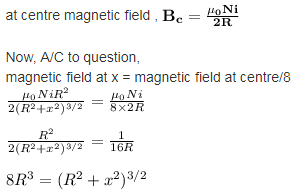
This is possible only when x = +-√3R
Hence, √3R distance from the centre magnetic field is equal to magnetic field at centre .
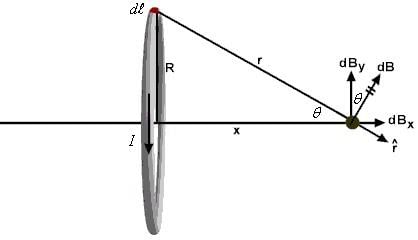

Infinite number of straight wires each carrying current I are equally placed as shown in the figure. Adjacent wires have current in opposite direction. Net magnetic field at point P is 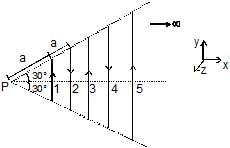
- a)

- b)

- c)

- d)Zero
Correct answer is option 'B'. Can you explain this answer?
Infinite number of straight wires each carrying current I are equally placed as shown in the figure. Adjacent wires have current in opposite direction. Net magnetic field at point P is
a)
b)
c)
d)
Zero
|
|
Anaya Patel answered |
Magnetic field at P is equal to the magnetic field due to AB,CD,EF and so on.
Magnetic field due to AB is +Z direction.
and CD is negative −Z direction and EP is positive +Zdrection and so on.
BP= (μ0I/4πd1) [sin30°−sin(−30°)k]+ (μ0I/4πd2)[sin30°−sin(−30°)l−k]+ μ0I /4πd3 [sin30°−sin(−30°)k]+...∞
BP=2sin30°× (μ0I/4π) [(1/d1)−(1/d2)+(1/d3)−(1/d4)+(1/d5)....∞]k
= μ0I/4π [(1/acos30°)−(1/2acos30°)+(1/3acos30°)−....∞]k
= μ0I/4π(acos30°) [1−(1/2)+(1/3)−(1/4)+(1/5)....∞]k
=(2μ0I/4π√3a) ln(1+1)k= (μ0I/4π√3a) ln22k=(μ0I/4π√3a) ln4k
Magnetic field due to AB is +Z direction.
and CD is negative −Z direction and EP is positive +Zdrection and so on.
BP= (μ0I/4πd1) [sin30°−sin(−30°)k]+ (μ0I/4πd2)[sin30°−sin(−30°)l−k]+ μ0I /4πd3 [sin30°−sin(−30°)k]+...∞
BP=2sin30°× (μ0I/4π) [(1/d1)−(1/d2)+(1/d3)−(1/d4)+(1/d5)....∞]k
= μ0I/4π [(1/acos30°)−(1/2acos30°)+(1/3acos30°)−....∞]k
= μ0I/4π(acos30°) [1−(1/2)+(1/3)−(1/4)+(1/5)....∞]k
=(2μ0I/4π√3a) ln(1+1)k= (μ0I/4π√3a) ln22k=(μ0I/4π√3a) ln4k
If a charged particle goes undeflected in a region containing electric and magnetic fields. Select all of the following statements that must be true for this.1.  must be perpendicular to
must be perpendicular to
2.  must be perpendicular to
must be perpendicular to
3. E must be perpendicular to u B.
4.  must be perpendicular to
must be perpendicular to
- a)1 and 3 only
- b)1 only
- c)1 and 2 only
- d)2 only
Correct answer is option 'A'. Can you explain this answer?
If a charged particle goes undeflected in a region containing electric and magnetic fields. Select all of the following statements that must be true for this.
1.  must be perpendicular to
must be perpendicular to
2. must be perpendicular to
must be perpendicular to
3. E must be perpendicular to u B.
4. must be perpendicular to
must be perpendicular to
2.
3. E must be perpendicular to u B.
4.
a)
1 and 3 only
b)
1 only
c)
1 and 2 only
d)
2 only
|
|
Lavanya Menon answered |
If a charged particle goes unaccelerated in a region containing
electric and magnetic fields,
electric and magnetic fields,

The force acting on a charge q moving with velocity in a magnetic field
in a magnetic field is given by
is given by- a)

- b)

- c)

- d)

Correct answer is option 'C'. Can you explain this answer?
The force acting on a charge q moving with velocity in a magnetic field
in a magnetic field is given by
is given by
a)
b)
c)
d)
|
|
Neha Sharma answered |
The magnetic force on a free moving charge is perpendicular to both the velocity of the charge and the magnetic field with direction given by the right hand rule . The force is given by the charge times the vector product of velocity and magnetic field.
What kinds of materials are used for coating magnetic tapes?- a)Diamagnetic Materials
- b)Ferrites
- c)Electromagnet
- d)Paramagnetic materials
Correct answer is option 'B'. Can you explain this answer?
What kinds of materials are used for coating magnetic tapes?
a)
Diamagnetic Materials
b)
Ferrites
c)
Electromagnet
d)
Paramagnetic materials

|
Divey Sethi answered |
Ceramics are used for coating magnetic tapes in a cassette player or for building memory stores in a modern computer. Ceramics are specially treated barium-iron oxides and are also called ferrites.
Electrons moving with different speeds enter a uniform magnetic field in a direction perpendicular to the field. They will move along circular paths.- a)of same radius
- b)with larger radii for the faster electrons
- c)with smaller radii for the faster electrons
- d)either (B) or (C) depending on the magnitude of the magnetic field
Correct answer is option 'B'. Can you explain this answer?
Electrons moving with different speeds enter a uniform magnetic field in a direction perpendicular to the field. They will move along circular paths.
a)
of same radius
b)
with larger radii for the faster electrons
c)
with smaller radii for the faster electrons
d)
either (B) or (C) depending on the magnitude of the magnetic field
|
|
Harsh Singhal answered |
R=Mv/qB
A short bar magnet has a magnetic moment of 0.48 J/T .Magnetic field produced by the magnet at a distance of 10 cm from the centre of the magnet on the axis has a direction and magnitude of .- a)1.06 G along S-N direction.
- b)0.96 G along S-N direction.
- c)0.86 G along S-N direction.
- d)0.76 G along S-N direction.
Correct answer is option 'B'. Can you explain this answer?
A short bar magnet has a magnetic moment of 0.48 J/T .Magnetic field produced by the magnet at a distance of 10 cm from the centre of the magnet on the axis has a direction and magnitude of .
a)
1.06 G along S-N direction.
b)
0.96 G along S-N direction.
c)
0.86 G along S-N direction.
d)
0.76 G along S-N direction.
|
|
Tanuja Kapoor answered |
Here M=0.48JT−1,d=10cm=0.1m
On axis,
B= (μ0/4π)(2M/d3)=10−7×(2×0.48/0.13)=0.96×10−4T
On axis,
B= (μ0/4π)(2M/d3)=10−7×(2×0.48/0.13)=0.96×10−4T
The units of magnetic pole strength and magnetic dipole moment of a bar magnet are- a)A-m, JT-1
- b)JT-1, Am-1
- c)JT-1, Am
- d)Am-1, JT-1
Correct answer is option 'A'. Can you explain this answer?
The units of magnetic pole strength and magnetic dipole moment of a bar magnet are
a)
A-m, JT-1
b)
JT-1, Am-1
c)
JT-1, Am
d)
Am-1, JT-1
|
|
Anaya Patel answered |
The units of magnetic pole strength is (A-m) and magnetic dipole moment of a bar magnet is (JT-1)
A particle having charge of 1 C, mass 1 kg and speed 1 m/s enters a uniform magnetic field, having magnetic induction of 1 T, at an angle q = 30° between velocity vector and magnetic induction. The pitch of its helical path is (in meters)- a)

- b)

- c)

- d)P
Correct answer is option 'B'. Can you explain this answer?
A particle having charge of 1 C, mass 1 kg and speed 1 m/s enters a uniform magnetic field, having magnetic induction of 1 T, at an angle q = 30° between velocity vector and magnetic induction. The pitch of its helical path is (in meters)
a)
b)
c)
d)
P

|
Sushil Kumar answered |
Pitch =Vcosθ×T
=Vcosθ×(2πm/qB)
Where m=1kg, q=1C, B=1T, V=1 m/s
=√3π .
=Vcosθ×(2πm/qB)
Where m=1kg, q=1C, B=1T, V=1 m/s
=√3π .
A neutron, a proton, an electron and an a-particle enters a uniform magnetic field with equal velocities. The field is directed along the inward normal to the plane of the paper. Which of these tracks followed are by a - particle.
- a)A
- b)B
- c)C
- d)D
Correct answer is option 'B'. Can you explain this answer?
A neutron, a proton, an electron and an a-particle enters a uniform magnetic field with equal velocities. The field is directed along the inward normal to the plane of the paper. Which of these tracks followed are by a - particle.
a)
A
b)
B
c)
C
d)
D
|
|
Om Desai answered |
Path C is undeviated. Therefore, it is of neutron's path. From Fleming's left-hand rule magnitude force on positive charge will be leftwards and on negative charge is rightwards. Therefore, tack D is of electron. Among A and B one of proton and other of α−particle ≤.
Further, r=mv/Bq or r∝m/q
Since, (m/q)>(m/q)P
∴rα>rP
or track B is of α particle.
Further, r=mv/Bq or r∝m/q
Since, (m/q)>(m/q)P
∴rα>rP
or track B is of α particle.
At a given place on the Earth’s surface, the horizontal component of Earth’s magnetic field is 9 × 10-5 T and the resultant magnetic field is 180 × 10-6. Calculate the angle of dip at this place.- a)45o
- b)0o
- c)60o
- d)30o
Correct answer is option 'C'. Can you explain this answer?
At a given place on the Earth’s surface, the horizontal component of Earth’s magnetic field is 9 × 10-5 T and the resultant magnetic field is 180 × 10-6. Calculate the angle of dip at this place.
a)
45o
b)
0o
c)
60o
d)
30o
|
|
Hansa Sharma answered |
Given: H = 9 × 10-5; R = 180 × 10-6 = 18 × 10-5
The required equation ➔ H=Rcosδ

Therefore, δ = cos-1 1/2
The required equation ➔ H=Rcosδ

Therefore, δ = cos-1 1/2
=60o
Thus, the angle of dip is 60o.
Thus, the angle of dip is 60o.
Two long thin, parallel conductors carrying equal currents in the same direction are fixed parallel to the x–axis, one passing through y = a and the other through y = –a. The resultant magnetic field due to the two conductors at any point is B. Which of the following are correct ? 
- a) B = 0 for all points on the x-axis
- b)At all points on the y-axis, excluding the origin, B has only a z-component.
- c)At all point of the z-axis, excluding the origin, B has only a y-component.
- d)B cannot have an x-component.
Correct answer is option 'A,B,C'. Can you explain this answer?
Two long thin, parallel conductors carrying equal currents in the same direction are fixed parallel to the x–axis, one passing through y = a and the other through y = –a. The resultant magnetic field due to the two conductors at any point is B. Which of the following are correct ?
a)
B = 0 for all points on the x-axis
b)
At all points on the y-axis, excluding the origin, B has only a z-component.
c)
At all point of the z-axis, excluding the origin, B has only a y-component.
d)
B cannot have an x-component.
|
|
Preeti Khanna answered |
On x-axis
A. B=(μ0I/2πa)- (μ0I/2πa)=0
B. On y axis say at (y, 0, 0)
B=[-μ0I/2π(a+y)]k + [μ0I/2π(a-y)]k
So except at origin, B has only z-components.
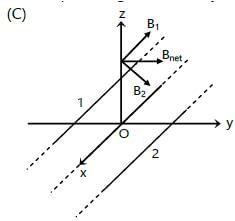 B cannot have x-component as B is perpendicular to direction of I.
B cannot have x-component as B is perpendicular to direction of I.
A. B=(μ0I/2πa)- (μ0I/2πa)=0
B. On y axis say at (y, 0, 0)
B=[-μ0I/2π(a+y)]k + [μ0I/2π(a-y)]k
So except at origin, B has only z-components.
 B cannot have x-component as B is perpendicular to direction of I.
B cannot have x-component as B is perpendicular to direction of I. An electron is moving along positive x-axis. A uniform electric field exists towards negative y-axis. What should be the direction of magnetic field of suitable magnitude so that net force of electron is zero.- a)Positive z-axis
- b)Negative z-axis
- c)Positive y-axis
- d)Negative y-axis
Correct answer is option 'B'. Can you explain this answer?
An electron is moving along positive x-axis. A uniform electric field exists towards negative y-axis. What should be the direction of magnetic field of suitable magnitude so that net force of electron is zero.
a)
Positive z-axis
b)
Negative z-axis
c)
Positive y-axis
d)
Negative y-axis

|
Abhishek Pal answered |
Negative z direction
A uniform beam of positively charged particles is moving with a constant velocity parallel to another beam of negatively charged particles moving with the same velocity in opposite direction separated by a distance d. The variation of magnetic field B along a perpendicular line draw between the two beams is best represented by- a)
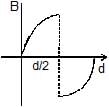
- b)

- c)
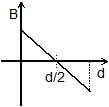
- d)
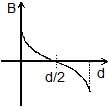
Correct answer is option 'D'. Can you explain this answer?
A uniform beam of positively charged particles is moving with a constant velocity parallel to another beam of negatively charged particles moving with the same velocity in opposite direction separated by a distance d. The variation of magnetic field B along a perpendicular line draw between the two beams is best represented by
a)
b)
c)
d)
|
|
Krishna Iyer answered |
Currents are in the same direction, so at the middle B=D
And the B varies exponentially not linearly,
So,
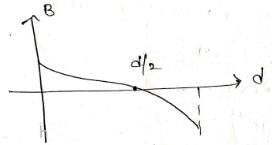
And the B varies exponentially not linearly,
So,

The force between two current carrying conductors is due to which of the following- a)Magnetic effect of electric current
- b)Electrostatic interaction
- c)Electromagnetic induction
- d)Polarisation
Correct answer is option 'A'. Can you explain this answer?
The force between two current carrying conductors is due to which of the following
a)
Magnetic effect of electric current
b)
Electrostatic interaction
c)
Electromagnetic induction
d)
Polarisation

|
Virat answered |
Current carring wire produce magnetic field
Which of the following laws give the direction of induced e.m.f- a)Faraday’s Law
- b)Ampere’s Theorem
- c)Biot Savart Law
- d)Lenz’s Law
Correct answer is option 'D'. Can you explain this answer?
Which of the following laws give the direction of induced e.m.f
a)
Faraday’s Law
b)
Ampere’s Theorem
c)
Biot Savart Law
d)
Lenz’s Law

|
Knowledge Hub answered |
Lenz’s law is used for determining the direction of induced current.
Lenz’s law of electromagnetic induction states that the direction of induced current in a given magnetic field is such that it opposes the induced change by changing the magnetic field.
Following is the formula of Lenz’s law:
ϵ=−N (∂ϕB/∂t)
Where,
- ε is the induced emf
- ∂ΦB is the change in magnetic flux
- N is the number of turns in the coil
Lenz’s law finds application in electromagnetic braking and in electric generators
A Charge is fired through a magnetic field. The magnetic force acting on it is maximum when the angle between the direction of motion and magnetic field is- a)π
- b)zero
- c)π/2
- d)π/4
Correct answer is option 'C'. Can you explain this answer?
A Charge is fired through a magnetic field. The magnetic force acting on it is maximum when the angle between the direction of motion and magnetic field is
a)
π
b)
zero
c)
π/2
d)
π/4
|
|
Krishna Iyer answered |
The force will have a magnitude F=qvB sin q, thus it will be maximum if sin q is maximum. Thus, angle between velocity and magnetic field should be 90o or the charge particle moves perpendicular to the velocity vector.
A rectangular loop carrying a current I is situated near a long straight wire such that the wire is parallel to the one of the sides of the loop and is in a plane of the loop. If a steady current I is established in wire as shown in figure, the loop will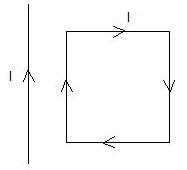
- a)move away from the wire or towards right
- b)remain stationary
- c)rotate about an axis parallel to the wire
- d)move towards the wire
Correct answer is option 'D'. Can you explain this answer?
A rectangular loop carrying a current I is situated near a long straight wire such that the wire is parallel to the one of the sides of the loop and is in a plane of the loop. If a steady current I is established in wire as shown in figure, the loop will
a)
move away from the wire or towards right
b)
remain stationary
c)
rotate about an axis parallel to the wire
d)
move towards the wire

|
Top Rankers answered |
The long straight wire and side AB carry current in the same direction, hence will attract each other.
The long straight wire and side CD carry current in the opposite direction, hence will repel each other.
Force on side BC will be equal and opposite to force on side DA.
Since CD is farther from the wire than AB, the force of attraction on AB will exceed the force of repulsion on CD.
Hence, there will be a net force of attraction on the loop ABCD and it will move towards the wire.
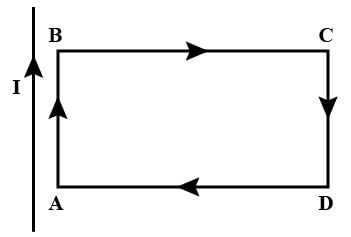
The long straight wire and side CD carry current in the opposite direction, hence will repel each other.
Force on side BC will be equal and opposite to force on side DA.
Since CD is farther from the wire than AB, the force of attraction on AB will exceed the force of repulsion on CD.
Hence, there will be a net force of attraction on the loop ABCD and it will move towards the wire.

When a charged particle enters a magnetic field in a direction perpendicular to the field, which one of the following does not change?- a)velocity of the particle.
- b)mass of the particle.
- c)energy of the particle.
- d)momentum of the particle
Correct answer is option 'C'. Can you explain this answer?
When a charged particle enters a magnetic field in a direction perpendicular to the field, which one of the following does not change?
a)
velocity of the particle.
b)
mass of the particle.
c)
energy of the particle.
d)
momentum of the particle
|
|
Geetika Shah answered |
The magnetic force acts perpendicular to the velocity of the particle. This causes circular motion. In the magnetic field the speed and kinetic energy of the particle remain constant, but the direction is altered at each instant by the perpendicular magnetic force.
A wire of length l, carrying current is bent into a loop and placed with its plane perpendicular to a magnetic field. In which of the following shapes, is the torque acting on the loop maximum?- a)Rectangle
- b)Circle
- c)Square
- d)Equilateral triangle
Correct answer is option 'B'. Can you explain this answer?
A wire of length l, carrying current is bent into a loop and placed with its plane perpendicular to a magnetic field. In which of the following shapes, is the torque acting on the loop maximum?
a)
Rectangle
b)
Circle
c)
Square
d)
Equilateral triangle
|
|
Om Desai answered |
The torque on a current loop depends upon the area of the current loop, when the magnetic field is perpendicular to the plane of the loops the torque has its maximum value,
Τ=I A B
We know I and B for all these cases but A depends upon the geometry. The circle has the greatest area so it should provide the greatest torque.
Τ=I A B
We know I and B for all these cases but A depends upon the geometry. The circle has the greatest area so it should provide the greatest torque.
In the magnetic meridian of a certain place, the horizontal component of the earth’s magnetic field is 0.26G and the dip angle is 600. What is the magnetic field of the earth at this location- a)0.65G
- b)0.62G
- c)0.58G
- d)0.52G
Correct answer is option 'D'. Can you explain this answer?
In the magnetic meridian of a certain place, the horizontal component of the earth’s magnetic field is 0.26G and the dip angle is 600. What is the magnetic field of the earth at this location
a)
0.65G
b)
0.62G
c)
0.58G
d)
0.52G
|
|
Om Desai answered |
The earth's magnetic field is Be and its horizontal and vertical components are He and Hv
cosθ= He/Be
∴cos60o= (0.26×10−4/ Be )T
⇒Be=(0.26×10−4)/ (½)=0.52×10−4T=0.52G
cosθ= He/Be
∴cos60o= (0.26×10−4/ Be )T
⇒Be=(0.26×10−4)/ (½)=0.52×10−4T=0.52G
A Rowland ring of mean radius 15 cm has 3500 turns of wire wound on a ferromagnetic core of relative permeability 800. What is the magnetic field B in the core for a magnetising current of 12 A ?- a)4.48 T
- b)5.48 T
- c)44.8 T
- d)48 T
Correct answer is option 'A'. Can you explain this answer?
A Rowland ring of mean radius 15 cm has 3500 turns of wire wound on a ferromagnetic core of relative permeability 800. What is the magnetic field B in the core for a magnetising current of 12 A ?
a)
4.48 T
b)
5.48 T
c)
44.8 T
d)
48 T
|
|
Sankar Singh answered |
Calculation of Magnetic Field B in the Core
Given:
Mean radius of Rowland ring, r = 15 cm = 0.15 m
Number of turns of wire, N = 3500
Relative permeability of ferromagnetic core, μr = 800
Magnetising current, I = 12 A
The magnetic field B in the core of Rowland ring can be calculated using the formula:
B = (μ0 * N * I) / (2 * r)
where, μ0 is the permeability of free space
μ0 = 4π * 10^-7 Tm/A
Substituting the given values in the formula,
B = (4π * 10^-7 Tm/A * 3500 * 12 A) / (2 * 0.15 m)
B = 4.48 T
Therefore, the magnetic field B in the core of Rowland ring for a magnetising current of 12 A is 4.48 T, which is option A.
Given:
Mean radius of Rowland ring, r = 15 cm = 0.15 m
Number of turns of wire, N = 3500
Relative permeability of ferromagnetic core, μr = 800
Magnetising current, I = 12 A
The magnetic field B in the core of Rowland ring can be calculated using the formula:
B = (μ0 * N * I) / (2 * r)
where, μ0 is the permeability of free space
μ0 = 4π * 10^-7 Tm/A
Substituting the given values in the formula,
B = (4π * 10^-7 Tm/A * 3500 * 12 A) / (2 * 0.15 m)
B = 4.48 T
Therefore, the magnetic field B in the core of Rowland ring for a magnetising current of 12 A is 4.48 T, which is option A.
Chapter doubts & questions for Magnetism - Physics for JAMB 2025 is part of JAMB exam preparation. The chapters have been prepared according to the JAMB exam syllabus. The Chapter doubts & questions, notes, tests & MCQs are made for JAMB 2025 Exam. Find important definitions, questions, notes, meanings, examples, exercises, MCQs and online tests here.
Chapter doubts & questions of Magnetism - Physics for JAMB in English & Hindi are available as part of JAMB exam.
Download more important topics, notes, lectures and mock test series for JAMB Exam by signing up for free.
Physics for JAMB
259 videos|253 docs|230 tests
|

Contact Support
Our team is online on weekdays between 10 AM - 7 PM
Typical reply within 3 hours
|
Free Exam Preparation
at your Fingertips!
Access Free Study Material - Test Series, Structured Courses, Free Videos & Study Notes and Prepare for Your Exam With Ease

 Join the 10M+ students on EduRev
Join the 10M+ students on EduRev
|

|
Create your account for free
OR
Forgot Password
OR
Signup to see your scores
go up within 7 days!
Access 1000+ FREE Docs, Videos and Tests
Takes less than 10 seconds to signup

